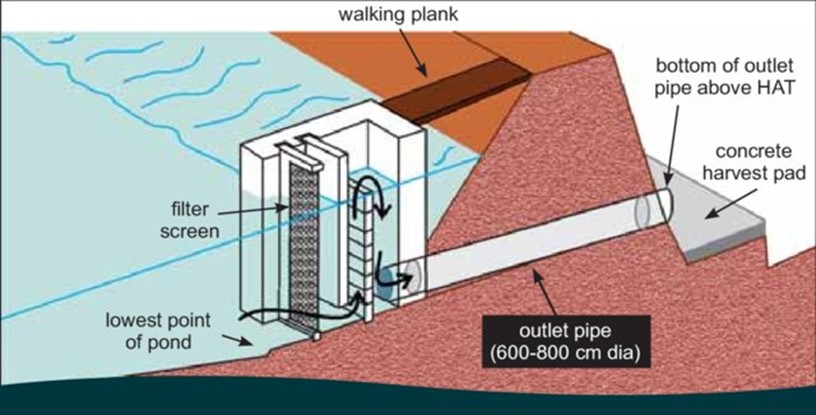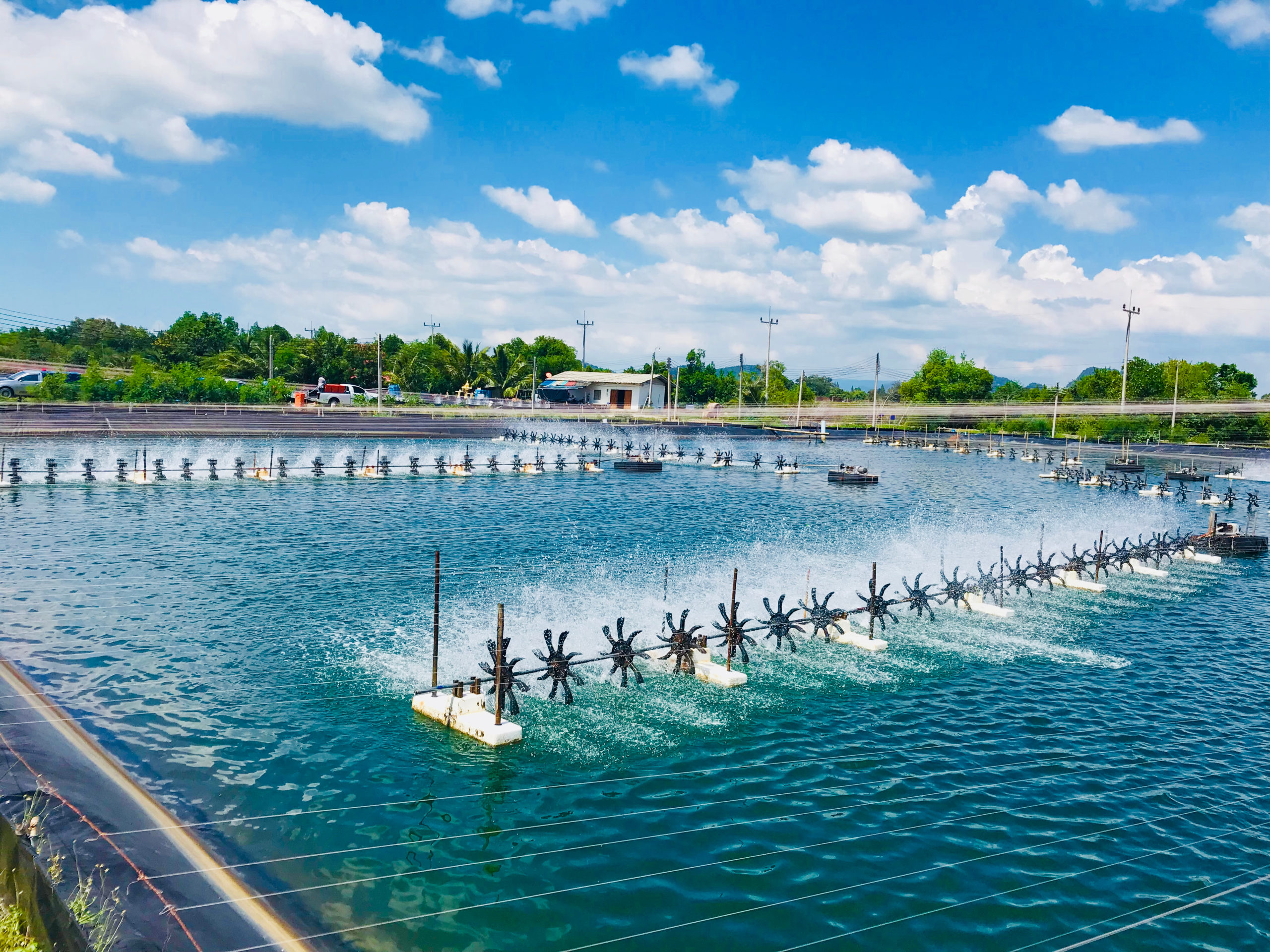As we have mentioned on several occasions, optimal shrimp farm management is always dependent on infrastructure. Whether it’s a Recirculating Aquaculture System placed in a closed greenhouse or an open system earthen pond located in the open, no one infrastructure solution resolves all aquaculture problems, so we have to choose carefully the design that best fit our conditions (in terms of capital investment, experienced and specialized labor, labor costs, input costs, market price, risk, etc.).
“Depending on the infrastructure”. We tend to hear this phrase over and over again when reading about any tips, new technologies, management systems, feeds, even consultants, almost anything related to aquaculture, so what is infrastructure? Well, basically, this term refers to the facilities and systems of all the components that form, in this case, a shrimp farm. From the shape and materials of tanks and ponds to their placement and design all the way through the pumps, filters, and piping. These elements (in some cases, including other stuff, like vehicles, machinery, or processing plants) are the components of a farm’s infrastructure.
In the following deliveries of the series, we will be discussing some of the most important elements to observe when talking and determining the best components for our farm’s infrastructure. Since this is a large topic, the infrastructure section will be delivered in two different installments. In the first one, we’ll discuss tanks and ponds, their design and considerations, and on the second one, we’ll cover the “guts” of the farm, that is, the water pumping and treatment.
First, let’s talk about tanks. Further on, when using the term tanks, we’ll include all ponds and aquariums considered in production unless stated otherwise.
The tank is the fundamental component of an aquaculture production system. One cannot produce without a tank; instead, it’s possible (although not recommended) to produce using only a tank, without the rest of the infrastructure components. So choosing the correct kind of tank is essential for successful aquaculture production.
Basically, a tank is a container that needs to be able to hold water. Since the definition is so broad, almost anything can be a tank, as long as it can store water. We will talk about the most common shapes, materials, and elements that facilitate shrimp farming to reduce the possibilities.
Shape
Tanks can take any shape imaginable. In most cases, when tanks are different from earth ponds, they are either circular or rectangular, making their management easier.
Different shapes have pros and cons. The most common kind of tank is the earth pond. Earth ponds are polygons, and their shape depends on the shape of the available land. These have the advantage of optimizing the use of space. The polygon shape maximizes the use of land, reducing waste. On the downside, earth polygon ponds are sometimes more challenging to manage (for example, the water column is uneven along the pond), clean and maintain.
Furthermore, if the soil isn’t correctly treated, it can erose, and the farm might become non-fit for shrimp farming. To avoid some of these problems, some farmers cover their earth ponds with plastic (like geomembrane); this way, cleaning becomes more manageable, and when the plastic wears out, it can be replaced, making the farmland fit for production sustainably in time. Not all farmers cover their ponds with plastic because of the cost associated with this practice. Usually, earth ponds are huge in terms of area, say around 1 hectare per pond, that is 10,000 m2, since geomembrane can cost around 20 USD per m2, covering an average 1 ha pond would cost 2 million USD, plus labor, so this practice is reserved for farmers with a lot of investment capital available. That being said, the investment is worth it since production density can significantly increase, increasing productivity and, if well managed, profitability and sustainability of the farm.
Apart from irregular polygons typical of earth ponds, tanks come, in general, in two shapes, circular and rectangular. Rectangular tanks have the advantage of land optimization, but they have one significant disadvantage, the corners. After a series of production cycles, corners in rectangular tanks tend to keep organic matter and, in the worst of cases, pathogenic viruses and bacteria. Cleaning rectangular tanks is much harder than circular ones, making them less biosecure.
On the other hand, circular tanks are easier to clean and, due to their shape characteristics, easier to manage, increasing biosecurity. On the downside, circular tanks reduce the optimal land use, leaving unproductive spaces and reducing productivity per unit of area.
Material
Another significant component of a tank is the material used. Apart from earth used in ponds, three materials stand out in aquaculture for tank design.
The first is concrete. Concrete tanks have the advantage of being very sturdy and long-lasting. They can be constructed in any shape, but once built, they are not flexible. Concrete by itself has high porosity, which means it needs to be treated, either covered with non-toxic paint or by some type of plastic. In terms of capital, concrete is in the high end compared with other materials. Investment can be higher than with other materials listed in the following lines, but maintenance is relatively cheap and easy to get, so it could be worth it in the long run.
The second material we’ll discuss is, in fact, a group, plastics. Plastics come in many forms, qualities, porosities, and thicknesses. These factors will be the main drivers in terms of cost. Even though almost any plastic container can be used in aquaculture, we’ll focus on the most used group: geomembrane.
Geomembranes are synthetic plates designed to prevent water infiltration. These plates or sheets can be made of several types of plastic, being the most common PVC and polyethylene (both high and low density). High-density polyethylene geomembranes (or HDPE) are the most common material used in aquaculture due to their high resistance to suspended organic matter and chemical reactions. Their application and installation require specialized equipment, and once it sets in a shape, it’s impossible to recover its flexibility fully. Despite this, the capacity of cleaning, using chemicals, and shaping it in any form (including cones) without needing a mold makes it the most popular material used for tanks. Even though it might be an expensive material for covering large areas, it’s one of the cheapest ways of doing smaller circular tanks for hiper-intensive productions.

Finally, the third most used material for aquaculture tanks is fiberglass. Even though this is not used commonly in shrimp fattening, it’s a go-to material for larvae production. Fiberglass is light, sturdy, and very easy to clean. It allows the use of the majority of the chemicals used in aquaculture and resists the high concentrations of suspended organic matter. On the downside, this material is expensive and requires the creation of a mold to produce the shape wanted, making it extremely costly to go for non-market shapes.
Drain
We now know the shapes and materials that we can go for when designing the tanks that will compose our farm, but two elements of extreme importance can be overlooked and, if done so, can drastically reduce the probabilities of our farm to succeed: The water inlet and outlet or drain, and the harvest outlet.
On a farm scale, it’s important to remember that the water inlet needs to be up-current of the water discharge; otherwise, “new water” will have high nitrogen and ammonia levels and will be sucked for farm use, provoking a reduction on water quality when exchanged, leading to mortalities.

Back to tank level, let’s start with earth ponds. Each pond needs to be slightly leaned, with the slope in the discharge direction. The pond needs at least two gates; one between the pond and the reservoir, and another between the pond and the discharge channel. This way, if we need to exchange water, the second door is open for a period of time, then closed, and new water is introduced from the reservoirs. It’s important to have a mesh in both gates to prevent organisms’ escape.

Floodgate example presented in the Australian Prawn Farming Manual, 2006.
The pond’s bottom needs to be as flat and compressed as possible to reduce the creation of puddles and retention of organic matter that is a perfect place to foster bacteria growth, including pathogens.
For tanks other than earth bottom ones, it’s advised to have smaller, more manageable ponds with a slope towards the center and covered with a false floor, the slight slope concentrates waste in the center, and an opening with a controlled valve permits discharge from the center of the tank.

Example from Endresen and Klebert, 2020 “Loads and response on flexible conical and cylindrical fish cages: A numerical and experimental study based on full-scale values” in Ocean Engineering.

Side view of a circular tank design from Timmons et al., 1998 in “Review of circular tank technology and management” Aquacultural engineering.
The same system must be in place in rectangular tanks, but the shape difficult waste concentration and discharge optimization, retaining some of it in the angles at the bottom and corners.
The only consideration needed for the water inlet is that it must be placed at the top of the tank to reduce the interaction with the tank discharge, but not too high, minimizing waste mixing.
Finally, one element that can improve the farm’s performance and minimize harvest costs and inefficiencies is to have specific harvest considerations. For example, if possible, tanks can be elevated, or a ditch can be dug out to make the extraction of shrimp easier. In the floodgate image, we can see a harvest pad consideration; this way, it’s unnecessary to harvest inside the tank, reducing the labor costs and the time consumption associated with harvest.
Water flow
Even though this element is not part of the tank selection per se, when designing a farm’s infrastructure, the current created by the water in the tank is important. The flow will determine the feed dispersion and waste accumulation. Water flow is the main reason for selecting circular ponds instead of rectangular or squared ones. If done correctly, flow makes circular ponds “self-cleaning”.
Circular tanks work by injecting a flow of water tangentially to the tank wall at the tank’s outer radius, causing the water to revolve around the tank’s center. In addition, due to the properties of these tanks, a secondary flow is formed with a significant inward radial flow component at the tank’s bottom and an outward radial flow component at the tank’s surface. This inward radial flow along the tank’s bottom takes settleable solids to the center drain, giving circular tanks their intended self-cleaning property.
Unfortunately, a region in the central drain in a circular tank with such flow can present lower velocities and poor mixing, reducing the tank’s effectiveness. These can result in localized water quality gradients if not cared for, creating a dead zone where sediments can settle and collect.
These zones’ size is determined by tangential flows along the walls, the diameter, and the total flow rate out of the central underdrain.
As we can see, even the selection of a tank can be a significant factor that determines the profitability and success of a farm. On some occasions, farmers don’t know this information before they buy their tanks and just go for the cheaper options. This can result in inefficiencies that can be difficult to observe or, even worse, to reduced biosecurity and increased mortalities and productivity loss. In extreme cases, bad tank selection and management can result in the loss of investment and the failure of a farm as a whole.
Now we know how to select the tank that best serves our purposes. In the next article, we will discuss the second part of the infrastructure, from how to select a water pump to designing a good filtering system for water recirculation.
